
(a)
Interpretation:
The complete, detailed mechanism of a given compound synthesized from an acid chloride and water is to be drawn.
Concept introduction:
Answer to Problem 21.40P
The complete mechanism is

Explanation of Solution
The given molecule is
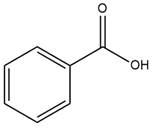
The carboxylic acid formation requires water as a nucleophile in the nucleophilic addition step. In this reaction,
In the first step, water acts as a nucleophile and adds to the carbonyl carbon of the acid chloride to produce a protonated intermediate ion. The

The protonated water is then deprotonated by a second molecule of the water.
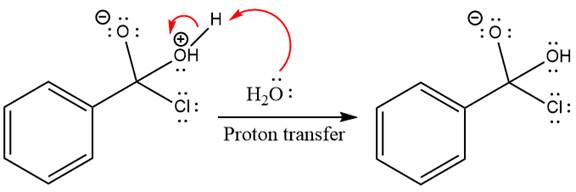
Finally, one lone pair on the negatively charged oxygen will move back to reform the carbonyl group, eliminating the chloride and forming the product.
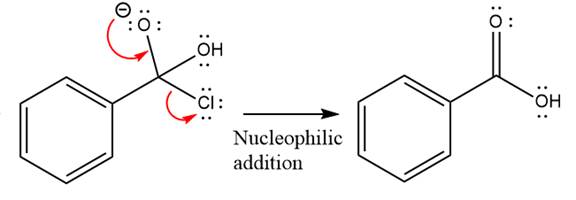
Thus, the complete mechanism can be drawn as

The product and mechanism of the given reaction were determined based on nucleophilic addition-elimination mechanism.
(b)
Interpretation:
The complete, detailed mechanism of a given compound synthesized from an acid chloride and water is to be drawn.
Concept introduction:
Carboxylic acid derivatives undergo acyl group substitution reactions when treated with appropriate nucleophiles. The reaction occurs via nucleophilic addition-elimination involving a tetrahedral intermediate. It may also involve proton transfer step(s), particularly when the nucleophile being added in the first step is not a strong nucleophile. The reaction occurs if the possible product is more stable than the reactant. If the two are of comparable stability, the reaction will occur reversibly.
Answer to Problem 21.40P
The complete mechanism is

Explanation of Solution
The given molecule is
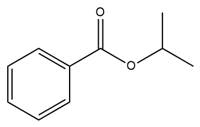
The ester formation requires isopropanol as a nucleophile in the nucleophilic addition step. In this reaction,
In the first step, isopropanol acts as a nucleophile and adds to the carbonyl carbon of the acid chloride to produce a protonated intermediate ion. The
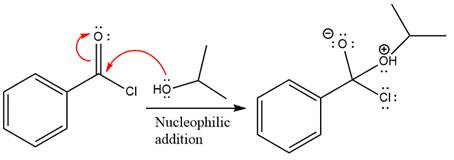
The protonated alcohol is then deprotonated by a second molecule of the isopropanol.
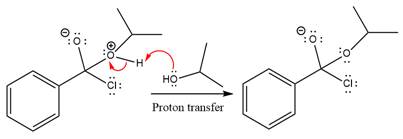
Finally, one lone pair on the negatively charged oxygen will move back to reform the carbonyl group, eliminating the chloride and forming the product.
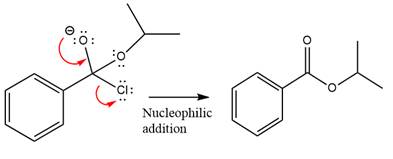
Thus, the complete mechanism can be drawn as

The product and mechanism of the given reaction were determined based on nucleophilic addition-elimination mechanism.
(c)
Interpretation:
The complete, detailed mechanism of a given compound synthesized from an acid chloride and water is to be drawn.
Concept introduction:
Carboxylic acid derivatives undergo acyl group substitution reactions when treated with appropriate nucleophiles. The reaction occurs via nucleophilic addition-elimination involving a tetrahedral intermediate. It may also involve proton transfer step(s), particularly when the nucleophile being added in the first step is not a strong nucleophile. The reaction occurs if the possible product is more stable than the reactant. If the two are of comparable stability, the reaction will occur reversibly.
Answer to Problem 21.40P
The complete mechanism is

Explanation of Solution
The given molecule is
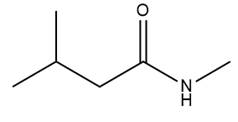
The amide formation requires
In the first step, amine acts as a nucleophile and adds to the carbonyl carbon of the acid chloride to produce a protonated intermediate ion. The

The protonated amine is then deprotonated by a second molecule of the amine.

Finally, one lone pair on the negatively charged oxygen will move back to reform the carbonyl group, eliminating the chloride and forming the product.

Thus, the complete mechanism can be drawn as

The product and mechanism of the given reaction were determined on the basis of nucleophilic addition-elimination mechanism.
(d)
Interpretation:
The complete, detailed mechanism of given compound synthesized from an acid chloride and water is to be drawn.
Concept introduction:
Carboxylic acid derivatives undergo acyl group substitution reactions when treated with appropriate nucleophiles. The reaction occurs via nucleophilic addition-elimination involving a tetrahedral intermediate. It may also involve proton transfer step(s), particularly when the nucleophile being added in the first step is not a strong nucleophile. The reaction occurs if the possible product is more stable than the reactant. If the two are of comparable stability, the reaction will occur reversibly.
Answer to Problem 21.40P
The complete mechanism is

Explanation of Solution
The given molecule is
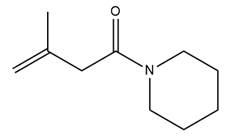
The amide formation requires amine as a nucleophile in the nucleophilic addition step. In this reaction,
In the first step, pyridine acts as a nucleophile and adds to the carbonyl carbon of the acid chloride to produce a protonated intermediate ion. The

The protonated pyridine is then deprotonated by a second molecule of the amine.

Finally, one lone pair on the negatively charged oxygen will move back to reform the carbonyl group, eliminating the chloride and forming the product.

Thus, the complete mechanism can be drawn as

The product and mechanism of the given reaction were determined based on nucleophilic addition-elimination mechanism.
Want to see more full solutions like this?
Chapter 21 Solutions
Organic Chemistry: Principles and Mechanisms (Second Edition)
- Epoxides can be opened in aqueous acid or aqueous base to produce diols (molecules with two OH groups). In this question, you'll explore the mechanism of epoxide opening in aqueous acid. 2nd attempt Be sure to show all four bonds at stereocenters using hash and wedge lines. 0 0 Draw curved arrows to show how the epoxide reacts with hydronium ion. 100 +1: 1st attempt Feedback Be sure to show all four bonds at stereocenters using hash and wedge lines. See Periodic Table See Hint H A 5 F F Hr See Periodic Table See Hintarrow_forward03 Question (1 point) For the reaction below, draw both of the major organic products. Be sure to consider stereochemistry. > 1. CH₂CH₂MgBr 2. H₂O 3rd attempt Draw all four bonds at chiral centers. Draw all stereoisomers formed. Draw the structures here. e 130 AN H See Periodic Table See Hint P C Brarrow_forwardYou may wish to address the following issues in your response if they are pertinent to the reaction(s) you propose to employ:1) Chemoselectivity (why this functional group and not another?) 2) Regioselectivity (why here and not there?) 3) Stereoselectivity (why this stereoisomer?) 4) Changes in oxidation state. Please make it in detail and draw it out too in what step what happens. Thank you for helping me!arrow_forward
- 1) Chemoselectivity (why this functional group and not another?) 2) Regioselectivity (why here and not there?) 3) Stereoselectivity (why this stereoisomer?) 4) Changes in oxidation state. Everything in detail and draw out and write it.arrow_forwardCalculating the pH at equivalence of a titration 3/5 Izabella A chemist titrates 120.0 mL of a 0.7191M dimethylamine ((CH3)2NH) solution with 0.5501 M HBr solution at 25 °C. Calculate the pH at equivalence. The pk of dimethylamine is 3.27. Round your answer to 2 decimal places. Note for advanced students: you may assume the total volume of the solution equals the initial volume plus the volume of HBr solution added. pH = ☐ ✓ 18 Ar Boarrow_forwardAlcohols can be synthesized using an acid-catalyzed hydration of an alkene. An alkene is combined with aqueous acid (e.. sulfuric acid in water). The reaction mechanism typically involves a carbocation intermediate. > 3rd attempt 3343 10 8 Draw arrows to show the reaction between the alkene and hydronium ion. that 2nd attempt Feedback 1st attempt تعمال Ju See Periodic Table See Hint F D Ju See Periodic Table See Hintarrow_forward
- Draw the simplified curved arrow mechanism for the reaction of acetone and CHgLi to give the major product. 4th attempt Π Draw the simplified curved arrow mechanism T 3rd attempt Feedback Ju See Periodic Table See Hint H -H H -I H F See Periodic Table See Hintarrow_forwardSelect the correct reagent to accomplish the first step of this reaction. Then draw a mechanism on the Grignard reagent using curved arrow notation to show how it is converted to the final product. 4th attempt Part 1 (0.5 point) Select the correct reagent to accomplish the first step of this reaction. Choose one: OA Mg in ethanol (EtOH) OB. 2 Li in THF O C. Li in THF D. Mg in THF O E Mg in H2O Part 2 (0.5 point) Br Part 1 Bri Mg CH B CH, 1 Draw intermediate here, but no arrows. © TE See Periodic Table See Hint See Hint ין Harrow_forwardSelect the product for the following reaction. HO HO PCC OH ○ OH O HO ○ HO HO HOarrow_forward
- 5:45 Х Select the final product for the following reaction sequence. O O 1. Mg. ether 2.D.Oarrow_forwardBased on the chart Two similarities between the molecule with alpha glycosidic linkages. Two similarities between the molecules with beta glycosidtic linkages. Two differences between the alpha and beta glycosidic linkages.arrow_forwardplease help fill in the tablearrow_forward
 ChemistryChemistryISBN:9781305957404Author:Steven S. Zumdahl, Susan A. Zumdahl, Donald J. DeCostePublisher:Cengage Learning
ChemistryChemistryISBN:9781305957404Author:Steven S. Zumdahl, Susan A. Zumdahl, Donald J. DeCostePublisher:Cengage Learning ChemistryChemistryISBN:9781259911156Author:Raymond Chang Dr., Jason Overby ProfessorPublisher:McGraw-Hill Education
ChemistryChemistryISBN:9781259911156Author:Raymond Chang Dr., Jason Overby ProfessorPublisher:McGraw-Hill Education Principles of Instrumental AnalysisChemistryISBN:9781305577213Author:Douglas A. Skoog, F. James Holler, Stanley R. CrouchPublisher:Cengage Learning
Principles of Instrumental AnalysisChemistryISBN:9781305577213Author:Douglas A. Skoog, F. James Holler, Stanley R. CrouchPublisher:Cengage Learning Organic ChemistryChemistryISBN:9780078021558Author:Janice Gorzynski Smith Dr.Publisher:McGraw-Hill Education
Organic ChemistryChemistryISBN:9780078021558Author:Janice Gorzynski Smith Dr.Publisher:McGraw-Hill Education Chemistry: Principles and ReactionsChemistryISBN:9781305079373Author:William L. Masterton, Cecile N. HurleyPublisher:Cengage Learning
Chemistry: Principles and ReactionsChemistryISBN:9781305079373Author:William L. Masterton, Cecile N. HurleyPublisher:Cengage Learning Elementary Principles of Chemical Processes, Bind...ChemistryISBN:9781118431221Author:Richard M. Felder, Ronald W. Rousseau, Lisa G. BullardPublisher:WILEY
Elementary Principles of Chemical Processes, Bind...ChemistryISBN:9781118431221Author:Richard M. Felder, Ronald W. Rousseau, Lisa G. BullardPublisher:WILEY





